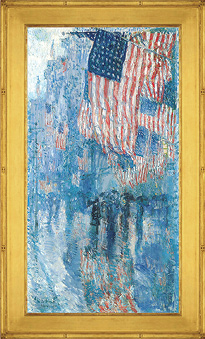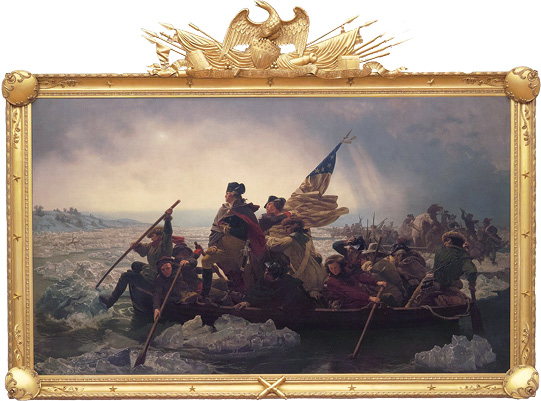- Home
- Media Kit
- Current Issue
- Past Issues
- Ad Specs-Submission
- Ad Print Settings
- Reprints (PDF)
- Photo Specifications (PDF)
- Contact Us

![]()
ONLINE

The Value of Frames
Editors’ Note
Eli Wilner is a leading frame dealer, frame restorer, and collector, as well as an acknowledged and published authority on the art of framing. His publications include Antique American Frames: Identification and Price Guide and The Gilded Edge. Wilner has framed over 10,000 paintings, including the spectacular frame for Washington Crossing the Delaware for The Metropolitan Museum of Art, and 28 paintings for the White House. Recently, Eli Wilner gave a presentation at the International Foundation for Art Research’s evening event, “What Frames Can Tell Us,” held at Christie’s New York. Eli Wilner has been doing frame evaluations and appraisals since 1978.
Company Brief
Eli Wilner & Company (eliwilner.com) is a Manhattan gallery, located on New York City’s Upper East Side. For over 30 years, Eli Wilner & Company has specialized in European and American period frames and frame restoration, boasting a vast inventory of over 3,500 frames (valued at over $120 million) spanning the 15th century through the present. Notably, the company produced a magnificent frame for Emmanuel Leutze’s Washington Crossing the Delaware at the behest of The Metropolitan Museum of Art. In addition, renowned auction houses such as Christie’s and Sotheby’s have relied upon Eli Wilner over the years to create hundreds of historically appropriate frames for their Old Master, Impressionist and Modern, American Art, and 19th Century European painting sales. Since 1983, Eli Wilner & Company has published over 100 articles about antique frames and collaborated extensively with curators from the Metropolitan Museum of Art, The Smithsonian American Art Museum, and The Cleveland Museum of Art. As further testament to their expertise in the field, Eli Wilner & Company worked with the Appraisers Association of America to develop the test that is given to certify appraisers of antique frames, and they recently evaluated a group of 271 frames that were donated to The Metropolitan Museum of Art by a prominent New York City art gallery.

Hassam – Avenue in the Rain, which hangs in the Oval Office
Will you talk about the history of the company and how it has evolved?
I started the company with $6,000 in my pocket. Art dealers, auction houses, and museums would gift me the frames out of their store rooms because, at the time, antique frames from the 19th and early 20th centuries had absolutely no value to them. I launched the business in the early ’80s and it has evolved into what I consider the finest service-oriented period frame dealership in the world. We pride ourselves on our special attentiveness to client needs, without hesitation. We have not yet had a client request that has been beyond the bounds of our innovative team.
Recently, we expanded our services into the philanthropic sector. Museums are at a point where they desperately require funding for framing. We have also evolved to address the needs of these not-for-profits.
Will you discuss the focus and impact of your philanthropy?
We have gifted over $20 million since 1983 in frame restoration and frame creation where a frame may have been lost. It has been our pleasure to transform over 100 institutions through over 500 meaningful projects including the framing of The Metropolitan Museum of Art’s Leutze. It was especially important to us to achieve perfection on this project, as our frame is not only the largest in the museum (12-foot by 21-foot), but also the most viewed.
Is the philanthropic focus a social responsibility of executives or is it also good for the business?
It is a responsibility of executives but it’s also the greatest marketing tool for any business. It’s something I started when I began the business, and it has become part and parcel of the business.
We recently gifted three frames to the museum at Columbia University. As a direct result, the Jewish Museum contacted us to purchase an identical frame to one we produced for Columbia for a large upcoming exhibition. Museums often exchange information with one another to the end of elevating their exhibitions, so we happily gift frames of the utmost quality to help museums achieve such success with the hope that it will lead to for-profit projects for our company in the future.
The more I give, the more I get back. It’s an incredible law of business that I am always surprised that others aren’t taking advantage of.

Metropolitan Museum of Art – Washington Crossing the Delaware
You’re also producing the Museum Frames Restoration Grant?
We conducted the Museum Frames Restoration Grant program over the summer, which was initially instituted as a competition between not-for-profits for a frame restoration project. We’re no longer hosting the grants as a competition because we prefer that no institution “lose.” So, if we receive a proposal in the future, in all likelihood, we will find a way to work with the institution if our workload permits.
How important is it for the culture within Eli Wilner to have this charitable commitment?
One of my key employees, who used to build sailboats, is my chief carpenter. He was the lead builder for the Leutze frame for the Met. He’s in his late 30s, and he told me he takes the greatest pride in what we do for museums; he shares it with his family, and it gives meaning to his life.
More and more, I see young people seeking meaning in their lives. Salary is secondary. That was not the case when I started in the business.
How critical is the right frame for the right painting?
Short answer: the right frame is critical to a painting. The artist would tell you the same thing. Throughout history, frames were often more expensive than the paintings.
The value of framing has never been taught in schools, which has been the impetus for my idea of another nonprofit institution that would offer courses and funding for the ongoing study of frames. I’m starting out slowly, but I have already hired three art professionals to write about frames. One is writing about the influence of Orientalism in 19th century frames where Arab subjects are depicted. Another is writing about scale, how it has affected the viewing of paintings through the ages, and more specifically, how an artist, collector or king would select frames based on their width and how they viewed their own importance through the paintings in a room. The third person will revamp a Ph.D. thesis on how artists have designed their own frames throughout history.
That is an ongoing interest of mine – It started by funding a Ph.D. thesis on frames about 10 years ago, but that will become more apparent over the next few years within my company.•